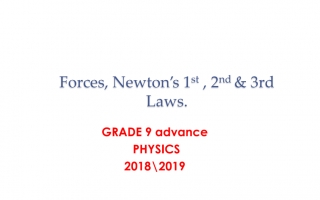Forces, Newton's 1st , 2nd & 3rd Laws.
GRADE 9 advance
PHYSICS
20182019
Name:
Grade 9 advance
Force & newton's laws
A force can cause:
change in state of motion of an object (acceleration).
change in shape of an object (deformation).
FORCE ↔ AECCELERATION
The force has symbol of F and SI unit of Newton N
The force is vector quantity; i.e. has magnitude and direction.
Forces can be divided into two main types:
1. Contact Forces
2. Field Forces
Contact Forces:
Contact Forces: forces that are exerted by touching the object. It is either push or pull.
Field Force
Field Forces: forces that are exerted without touching the object.
Magnetic force
Forces
Applied Force
Earths gravity force (weight)
Tension force
Normal force
Air resistance force
Friction force
Net Force
Net Force (resultant force) : is the combination of two or more forces acting on one object.
Symbol of net force is Fnet Or ΣF.
When two forces are in the same direction net addition direction is same as them
When two forces are in the opposite direction net force is their difference. direction is same as greater force
Balanced Forces
when the net force on an object is zero, then the object:
is at rest or is moving with constant velocity.
And in both cases the object is said to be in equilibrium.
Inertia:
is the tendency of an object to resist changes in velocity.
So;
an object at rest tends to stay at rest unless a net force moves it.
an object moving with constant velocity tends to stay like that unless a net force changes it.
Newton's First Law is called Law of Inertia.
States that : An object at rest remains at rest
and an object in motion continues in constant velocity ( straight line at constant speed), unless it experiences a net external force acting on it.
According to Newton's 1st Law:
when the net force acting on an object is zero,
then the object is at rest (velocity is zero)
or is moving with constant velocity (uniform motion).
Equilibrium
States that : An object at rest remains at rest
and an object in motion continues in constant velocity ( straight line at constant speed), unless it experiences a net external force acting on it.
when the net force on an object is zero,
the object is said to be in equilibrium. Fnet = 0.
Newton's First Law
Why the coin (in the picture) falls in the cup when the paper is pushed hard?
The coin and paper were at rest.
The pushing force acted on the paper and moved it.
The coin stayed at rest because of its inertia and felt down because of gravity.
Newton's First Law
Why wearing seatbelt is important to save lives?
Passengers in a car have the same velocity of the car.
When the car is stopped suddenly by a force (wall or brakes), the passengers keeps moving with the same velocity because of their inertia.
If the passengers were wearing their seatbelts, the seatbelts will exert force to stop them when the car stops.
Newton's 2nd Law
States that : The acceleration of an object is directly proportional to the net force and inversely proportional to the mass of the object.
From Newton's second law we can say :
- If the force increases, acceleration increases.
- If the mass increases, acceleration decreases,
Newton's second law can be expressed mathematically by the formula:
ΣF = Fnet = ma
m: mass Sl unit: kg
a: acceleration Sl unit: m/s2
F: force Sl unit: N
Newton's 2nd Law
Uniform Motion
no net force on object
no acceleration
velocity is constant or zero
described by 1st law
F = 0
a = 0
v = 0 or v = const.
Non Uniform Motion
there is net force on object
there is acceleration
velocity is changing
described by 2nd law
F = ma
a ≠ 0
v: changing
Newton's 2nd Law
EX 1:
If the mass of a plane is 2000 Kg and the net force on it is 16000 N, what is the plane's acceleration?
Data: m = 2000 kg Fnet = 16000 N a = ?
EX 2:
What is the net force on a car with a mass of 800 kg if its acceleration is 2 m/s2?
Data: m = 800 kg a = 2 m/s2 Fnet = ?
EX 3:
A wagon is being pulled by a horse. What is the wagon's mass if the net force on the wagon is 500 N and it has an acceleration of 2 m/s2?
Data: Fnet = 500 N a = 2 m/s2 m = ?
EX 4:
the engine force is 4100 N and friction force is 100 N. If the car's force mass is 1000 kg, find the car's acceleration.
Newton's 2nd Law
EX 5:
A 1000-kg car accelerates from 10 m/s to 26 m/s in 8 s. Calculate the net force acted on the car during that time.
Data: m = 1000 ;
Vi = 10;
Vf = 26 ;
t = 8
Fnet =?
EX 6:
A 3000-kg truck is at rest. If a net force of 6000 N exerted on the truck for 10 s, what will be the trucks speed after the 10 s?
Data: m = 3000;
Vi = 0 (at rest) ;
Fnet = 6000 ;
t = 10 ;
Vf = ?
Force & Acceleration
When a net force acts on object, one of the following happens:
Object deformed (change in shape)
Object accelerated (change in motion)
Object balanced (its in equilibrium)
The relation between force and acceleration in linear (direct proportional
questions:
Q1: If the mass of a plane is 500 Kg and the net force on it is 1200 N, what is the plane's acceleration?
Q2: What is the net force on a car with a mass of 600 kg if its acceleration is 3 m/s2?
Q3: A 2000-kg truck is at rest. If a net force of 4000 N exerted on the truck for 10 s, what will be the trucks speed after the 10 s?




